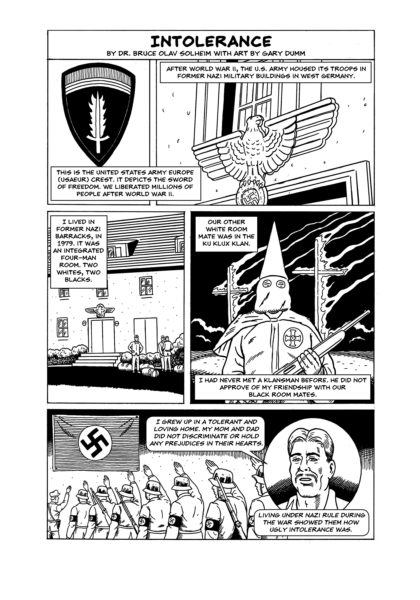Often times figuring out ways to get students more involved in class can be a challenge for educators, but history professor Bruce Solheim found a way through comic books.
He uses comics instead of plain PowerPoint presentations or textbooks, but instead integrates different life experiences into his lectures.
Some life experiences even include those experienced by his parents in their youth.
“My parents lived under Nazi occupation during WWII, so I grew up with those stories,” Solheim said, “ … when I’m teaching history and I talk about WWII, I have that personal connection and share that with the students which makes it much more real to them.”
Solheim said that all of the personal experiences work into the classroom and connect the students to the material, giving them a better understanding of the different concepts he teaches.
Solheim tried different professions ranging from engineering to being a prison guard, but in the end, he learned that he’s a historian, a storyteller, a writer and a playwright.
“I figured out I’m an artistic builder of stories. History is all about stories- personal connections,” Solheim said. “So my job is to empower students through stories in whatever way I can.”
Solheim’s preferred way of teaching became the use of a custom-made textbook.
The idea to integrate comic pages in his textbook “Making History: A Personal Approach to Modern American History”, was inspired by the comic book “American Splendor” created by Harvey Pekar.
“I decided to write my own text book,” Solheim said, “I got a comic book artist to do comic book pages for each chapter of the personal history section.”
He uses the comic book pages illustrated by artist Gary Dumm to lead group discussions and has students do three things: react to it, relate to it and then reflect on it.

Solheim wants to see how students feel about the comic and what way it relates to their personal lives. When the discussion is over, he has the group present their ideas and reflect on what they’ve discovered.
“The comics keep us more interested in learning about history and the fact that he ties it into himself,” one of Solheim’s current students, Amber Beaird, a sociology major, said. “I think it’s pretty cool how he relates the history to himself.”
In these discussions, students share their findings and perspective of the issue, while learning of what others believe.
“They’re connecting to the comic book, which connects to the personal story, which connects to the chapter, which connects to the whole course,” Solheim said.
Solheim believes that the comic book pages bring the stories to life and help keep the students’ interest. Blending the personal stories into the lectures make history more real for them, that’s why they’re able to connect with it.
“I think the comics give the textbook a more personal feel,” student Hunter Hanson, a communications major, said, “being able to relate to real life events help you understand the context of what we’re learning about a lot more.”
Solheim explains that teaching is an ongoing process and as a professor it’s important to realize how engaged he is in class and how is that affecting the students. He understands that one must show excitement for teaching and be willing to learn just as much as the students.
To start the process, in the beginning of the semester Solheim asks his students some existential questions that most don’t think about, “who are you? Why are you here?”
“I’m not looking for ‘my name is Joe and I’m looking to take this class for credit.’” Solheim said. “As long as we’re here together, let’s find our purpose. Let’s see if history can help us discover who we really are.”
“I personally never liked history, but when I read his book it actually keeps more interested and wanting to learn what history and his life are about,” Beaird said.
With the use of life experiences, his parents involvement in WWII and love for comic books, Bruce Solheim hopes not only to educate his students in a unique way, but to help them find a personal connection to history.


